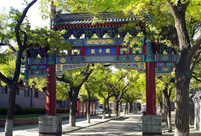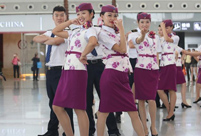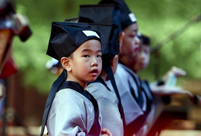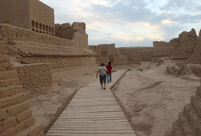 Global ambassadors of ecotourism gather in Nanjing
Global ambassadors of ecotourism gather in Nanjing
 Taiwan woman marries into Kazak family, 100 sheep plus a flat as dowry
Taiwan woman marries into Kazak family, 100 sheep plus a flat as dowry
 College girls take graduation photos under water in Chongqing
College girls take graduation photos under water in Chongqing
 Cartoon: Xi and football
Cartoon: Xi and football
 Chinese influence sweeps ROK
Chinese influence sweeps ROK
 Post-90s beauty boxer grapples four men
Post-90s beauty boxer grapples four men
 3,000-year-old tea town through lenses
3,000-year-old tea town through lenses
 22 archaeological sites along Silk Road in China
22 archaeological sites along Silk Road in China
 Football babies, Samba dancers embrace 'World Cup'
Football babies, Samba dancers embrace 'World Cup'
 Beautiful scenery along China’s Grand Canal
Beautiful scenery along China’s Grand Canal
BEIJING, July 4-- Five years after fatal violence left nearly 200 dead in the city of Urumqi, the concussion created by the watershed incident has not died down.
Bigoted Western critics have never stopped challenging the country's commitment to stabilizing and developing the restive region.
One of their persistent accusations against China's Xinjiang policy is that the nation's iron-fist crackdown on terrorism and religious extremism helps eliminate the traditional Uygur culture in the autonomous region, largely inhabited by ethnic Uygurs.
That logic is fallacious. It is the terrorists and extremists who are leading the time-honored Uygur culture into the danger of extinction.
The Uygurs in south Xinjiang have to stop singing, dancing and painting, all of which the group are historically talented in, after these behaviors are labeled "non-Islam" and threatened to be banned by some extremists.
Traditional Uygur clothing, which is usually colorful and a delicate blending of Islamic and Uygur ethnic cultures, is also under threat.
The religious extremists leave the Uygur women with no choice of attire but the burka and forced veiling. Any refusal could easily invite isolation, accusation of betrayal and even life danger.
As a matter of fact, deprived freedom of entertainment and forced burka wearing have never been a part of the Uygur heritage. The extremist groups are encroaching and annihilating the Uygur culture and hijacking Islam.
It is equally unreasonable and irritating as what was happening in Somalia and Pakistan, where under the extremists' rule, pop music was banned and any other religions were labeled as heresy with their icons eradicated.
By doing so, the extremists in Xinjiang aim to strengthen the religious identity of the Uygurs and weaken their ethnic identity before they can finally separate Xinjiang, one sixth of China's total landmass, from the country.
Religious extremism, the primary motivator of acts of terrorism worldwide, has prompted a spate of terrorist attacks inside and out of Xinjiang over the past five years.
The targets of these attacks have shifted from symbols of the government, such as public security stations and police vehicles, to civilians at railway terminals, markets and residential communities.
The nationwide panic and fear these terrorists have created has inevitably led to ethnic estrangement.
The entire Uygur ethnic group has been wrongly perceived by some as terrorists and jihadists. The Uygur culture has to some degree been misinterpreted and stigmatized.
China's uphill battle against terrorism in Xinjiang is a part of the world's counter-terrorism war. To win the battle is to protect the Uygur culture.
 Featured hutongs in Beijing
Featured hutongs in Beijing Separate college entrance exam
Separate college entrance exam Flash mob dance
Flash mob dance Picturesque scenery of Ghost City
Picturesque scenery of Ghost City Children attend First Writing Ceremony
Children attend First Writing Ceremony Female master poses for graduation photos with son
Female master poses for graduation photos with son Silk Road, China's Grand Canal listed as World Heritage Sites
Silk Road, China's Grand Canal listed as World Heritage Sites PKU students imitate famous paintings in real-person photos
PKU students imitate famous paintings in real-person photos Chinese 'Slumdog Millionaire'
Chinese 'Slumdog Millionaire' Islands in S. China Sea better shown on new vertical atlas of China
Islands in S. China Sea better shown on new vertical atlas of China Girl takes father’s portrait to travel the world
Girl takes father’s portrait to travel the world Images of Xi'an: Part one
Images of Xi'an: Part one In Pictures: Female fans of World Cup
In Pictures: Female fans of World Cup Top 20 hottest women in the world in 2014
Top 20 hottest women in the world in 2014  China's top 10 representative architectures
China's top 10 representative architecturesDay|Week|Month